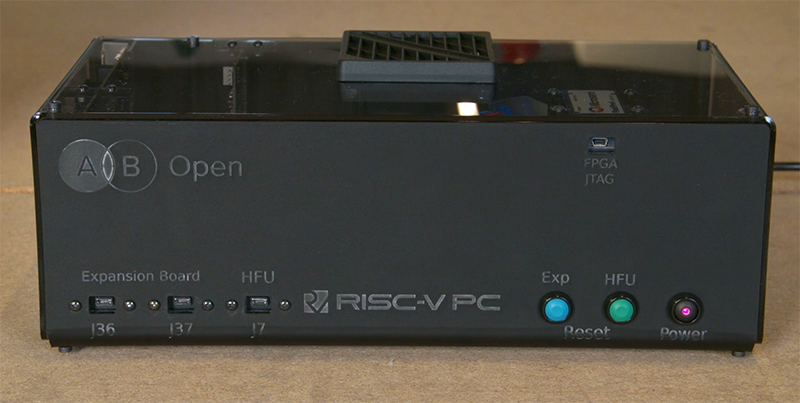If you want to talk about RISC-V, the Open Source instruction set for CPUs, you’re probably talking about microcontrollers. You can buy small but powerful RISC-V micros on par with an ARM Cortex-M4 right now. Deep in the pipeline are cores for something resembling SoCs, the kind you’d find in desktop NAS solutions, maybe a few routers, and smart TVs. This is great and all, but our idea of a ‘computer’ is still a desktop. When is the Open instruction set desktop coming? Well, it’s here right now. [Andrew Back] built a RISC-V desktop computer. It runs Linux, it comes in a case, it has HDMI and USB, there’s a graphics card in there somewhere, and it works. This is a desktop, running with a RISC-V core.
The core of this build is the HiFive Unleashed, a Linux-capable board from SiFive, makers of the first (production) RISC-V microcontroller. This board uses the Freedom U540 SOC built with a 28nm process, has 8GB of DDR4, and 32MB of Flash. For a board built on an Open archetecuture this is impressive, but it comes at a cost: the HiFive Unleashed ran for $1000 during its crowdfunding campaign.
But a board with an Open CPU does not a desktop make. You need peripheral IO, maybe a few PCIe, and hopefully a SATA interface. This problem has been solved by Microsemi with an Expansion board for the HiFive Unleashed. It includes a big ‘ol FPGA and all the connectors you could use. It also costs $2000.
With most of the parts ready to go, a few buttons, M.2 PCIe and SATA SSD storage, a graphics card, and a nice acrylic case were added. Thanks to Western Digital, building Linux was as easy as building Linux, and you end up with a desktop computer with a RISC-V brain.
Compared to a bog-standard ‘gaming machine’, this is an expensive build. The quick and dirty ballpark for the price is somewhere around $4000 USD for a machine that will let you check your Facebook. There’s a video of the machine running, you can check that out below.
















Building a risc-v computer and using it to browse Facebook, YouTube et al seems counter intuitive.
Well that all depends what you’re trying to achieve.
A commentary on the collision between two different kinds of “free”.
Yeah, definitely a riscy investment.
Don’t let perfect be the enemy of good. Steps in the right direction are at least progress.
50 years from now this machine may actually be worth $4,000 – as a collector’s item.
Yeah but $4000 will be worth about $1,038.60 in today’s dollars if inflation followed the same pattern as it has for the last 50 years.
Its intersting, every platform must start somewhere.
It would be nice if now that they have the Risc-V cores working, the people responsible for it would develop a similarly open chipset to easy the creation of desktop versions.
This is so expensive because it’s like building a PC using only the expensive development boards for the components. That $2000 expansion board is for doing all kinds of things, a pcie board should be much cheaper. If you were to have a custom Intel 64 bit processor with custom development boards and small quantity manufacturing, it would be similarly expensive.
This is a bit tangent to this, but is the device limited to booting off the SDcard and/or eMMC?
What sort of work would need to be done to support modular RAM?
I’d like to have something that is much less integrated like desktops of a couple decades ago.
I’d like modular RAM I can upgrade, the ability to boot off an OS on a variety of mass storage devices located on a variety of possible IO buses, I’d like to be able to boot an OS that is precompiled and does not need to be recompiled to support changes in device configurations, and get back to a more open ecosystem where a group could do one aspect of computing, do it well, and users could pick up those improvements by replacing only the relevant part of their machine.
I know the modularity comes at the cost of software complexity and greater power draw. I also think we got a lot of good from this open nature of PCs before the SoC-ification that is happening today.
Why not develop a RISC-V card for building an HPC? Nothing more than the CPU, 8 or 16GB of RAM, enough flash to support basic diagnostics and a remote boot, and two network interfaces – one fast for inter-process comms and storage, and one for management. This could be the compute node. Now add 8 or 16 or a really big number of these compute nodes to a head node, which provides the interfaces to the outside world, also hosts the network boot volumes. Ta da.
btw it needs to have some blinkenlights.
As for the unit cost, it definitely gives one a perspective on the economies of scale achieved in the Wintel world. Meaning the costs involved for hardware/firmware and a complete computer.
Did they run **benchmarks** like passmark or something just to see where it stands?
BUT: Can it run Crysis? Sorry couldn’t help it.
I mean, if hypothetically there was a linux version of Crysis that could be licensed for it’s source that would be a amazing goal for RISC-V CPUs in order to demonstrate it’s compute ability along with the library and compiler support. The community should choose a graphically strenuous ( and with good physics, AI, etc ) game that can run on linux as a long term goal to show desktop readiness.